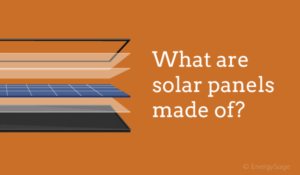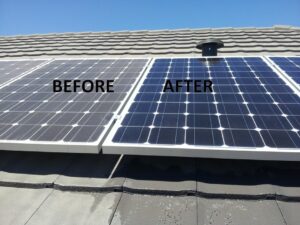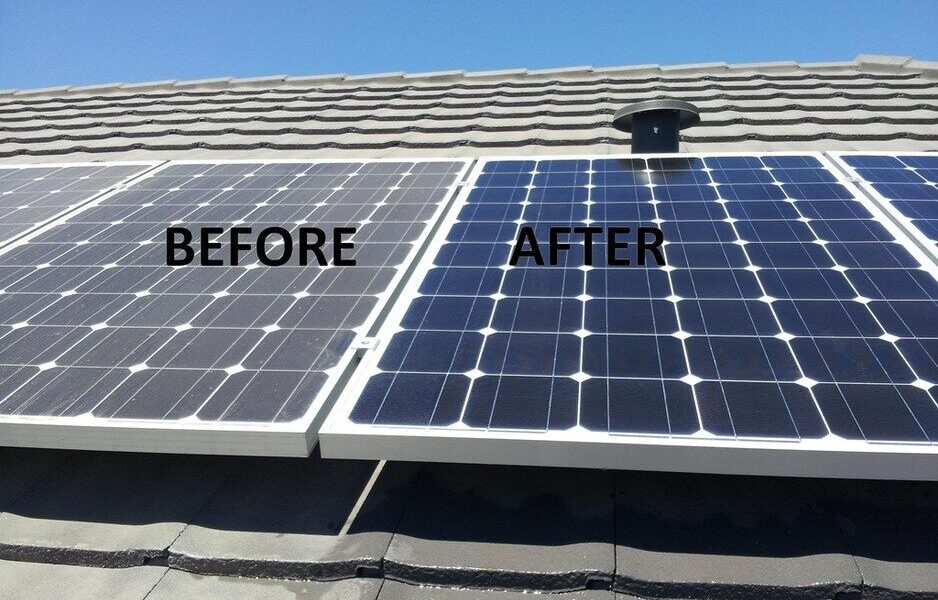CONSIDER  for your solar energy needs.
for your solar energy needs.
If you are looking for a good solar company to install solar. Call Simply Solar at 707-364-9588 Ask for Frank Hall
Solar Mod Cleaning Contract & Waiver
Solar has entered the mainstream as the world’s cheapest energy source, leaving many people wondering how solar PV can be so efficient and inexpensive while still providing “green” energy. Answering that question means understanding how solar energy work, how solar panels are made and what the parts of a solar panel are. Most panels available on the market are made of monocrystalline, polycrystalline, or thin film (“amorphous”) silicon. In this article, we’ll explain the different ways solar cells are made and what parts are required to manufacture a solar panel.

How are solar panels made? Mono vs poly vs thin film
Solar photovoltaics are made with a number of parts, the most important of which are silicon cells. Silicon, atomic number 14 on the periodic table, is a nonmetal with conductive properties that give it the ability to convert sunlight into electricity. When light interacts with a silicon cell, it causes electrons to be set into motion, which initiates a flow of electricity. This is known as the “photovoltaic effect.”
However, silicon cells alone can’t provide electricity for your home. They are paired with a metal casing and wiring, which allow the solar cell’s electrons to escape and supply useful power. Silicon comes in a number of different cell structures: single cell (monocrystalline), polycrystalline or amorphous forms, most commonly associated with thin film solar panels.
Monocrystalline (Most commonly used in residential) solar panels are produced from one large silicon block and are produced in silicon wafer formats. The manufacturing process involves cutting individual wafers of silicon that can be affixed onto a solar panel. Mono-crystalline silicon cells are more efficient than polycrystalline or amorphous solar cells. Producing individual monocrystalline wafers is more labor-intensive, and consequently, they are also more expensive to manufacture than polycrystalline cells. Monocrystalline cells have a distinct black aesthetic and are often associated with the sleek look.
Polycrystalline solar cells are also silicon cells, but rather than being formed in a large block and cut into wafers, they are produced by melting multiple silicon crystals together. Many silicon molecules are melted and then re-fused together into the panel itself. Polycrystalline cells are less efficient than monocrystalline cells, but they are also less expensive. They have a blueish hue.
Finally, amorphous silicon cells create flexible solar panel materials that are often used in thin film solar panels. Amorphous silicon cells are non-crystalline and instead are attached to a substrate like glass, plastic or metal. For this reason, thin film solar panels are true to their name: they are lean and bendable, unlike a standard panel. Though an ideal use case for versatility, amorphous solar cells are very inefficient compared to mono or polycrystalline cells.
Cadmium telluride (CdTe) is a stable crystalline compound formed from cadmium and tellurium. It is mainly used as the semiconducting material in cadmium telluride photovoltaics and an infrared optical window. It is usually sandwiched with cadmium sulfide to form a p-n junction solar PV cell.
Copper indium gallium selenide is a I-III-VI₂ semiconductor material composed of copper, indium, gallium, and selenium. The material is a solid solution of copper indium selenide and copper gallium selenide.
What are the parts of a solar panel?
The materials used to manufacture the cells for solar panels are only one part of the solar panel itself. The solar panel manufacturing process usually brings together six different components. If you are DIY-minded and curious about solar panel materials, it may even be a question of wanting a hypothetical “ingredients” list to produce one on your own. Here are the common parts of a solar panel:
- Silicon solar cells
- Metal frame (typically aluminum)
- Glass sheet for casing
- Standard 12V Wire
- Bus wire
- Plexiglas
In addition to the solar cells themselves, a standard solar panel includes a glass casing at the front of the panel to add durability and protection for the silicon PV. Under the glass exterior, the panel has a casing for insulation and a protective back sheet, which helps to limit heat dissipation and humidity inside the panel. The insulation is particularly important because temperature increases will lead to a decrease in efficiency, resulting in a lower solar panel output. Thus, PV manufacturers must go extra lengths to ensure that light is being captured without the technology being overheated.
Issues of Production of Solar Mods and Installations
Although a hands-on examination of the actual scratch, preexisting damage, is required to conclusively determine the cause, there are several commonly occurring trends. Listed below are some of the more frequent causes of scratched solar.
EXTERIOR SURFACE PROBLEMS
- As stated above, solar mods being delivered to the site with scratches are rare, but this does exist.
- Scratches can be caused by lathing wire being dragged across the glass during the installation of lathing wire and black paper.
- Unqualified Solar Mod Cleaners can scratch mods by not using proven Solar Mod Cleaning techniques to remove debris safely.
- Unqualified Pressure Washer companies can damage mods by not using proven Solar Mod Cleaning techniques to remove debris safely.
- The most devasting occurrence of damaging Solar Mods is when customers clean them themselves when some solar companies tell their clients to rinse them down with their hose water. Hose water generally contains minerals that will build up hard water staining on the mod surface.
- Solar Mods are prone to breakage if an object hits them like tree branches falling. Could be a number of things that hit solar. Think outside the box.
- Some solar companies claim you can stand on the solar panels. We do not recommend this at all.
ATTENTION – DO NOT USE HIGH PRESSURE OR LOW PRESSURE WASHING TO CLEAN SOLAR PANELS. WILL VOID WARRANTY OF YOUR INVESTMENT.
EXTERIOR SURFACE MANUFACTURER DEFECTS
1) Hot spots
Hot spots are places on the panels which are overloaded and therefore become warm. Hotspots on panels are mainly caused by badly-soldered connections, or are a result of a structural defect in the solar cells.
Badly-soldered connections cause low resistance in the part of the panel that receives the power generated by the cell. As a result, the voltage can rise, which leads to a hotspot in the soldered points and/or a cell. This phenomenon can ultimately lead to a short-circuit, and reduces the performance and lifespan of the PV panel. We have identified hot spots in several solar parks, leading to solar panels being replaced, adding significant Opex costs to those projects.
2) Micro-Cracks
One phenomenon we regularly encounter are ‘micro-cracks’ in crystalline PV panels. These are virtually imperceptible microscopic tears in the solar cells. Micro-cracks can occur during PV modules production, but also during shipping or due to careless handling practice during installation. Micro-cracks do not necessarily result in immediate production loss, incidentally, but can grow over time, for example due to thermal tension, or under the influence of seasonal and weather conditions. Larger micro-cracks will damage the solar cells, and this will lead to production loss.
Damage at the solar cell’s contact points will have a particularly significant influence on the cell’s energy production. Because the cells in the panel are wired in series, this will also impact on the power output in the entire panel. As a result, the panel’s performance decreases in direct correlation.
on to the number of broken cells. Multiple busbars are often installed in the more expensive panels in order to mitigate this problem. We have recently tested several module brands at different solar parks and found out that, on average, micro-cracks affect a high percentage of the modules, resulting in significant production loss (we have seen 2-3% performance shortfall related to micro-cracks).
3) Snail Trail Contamination
Snail trail is a discoloration of the panel which usually only manifests itself after a couple of years of production. Snail trails have multiple causes, but one cause can be attributed to the use of defective front metalization silver paste, in the solar cell manufacturing process. Defective silver paste can lead to moisture in the panel, and as a result of this moisture, an oxidation can occur between the silver paste and the encapsulation material called EVA (ethylene vinyl acetate).
This unwanted process releases silver oxide, acetic acid (vinegar) and hydrogen. The effect of this reaction is fed from the back of the panel to the front of the panel, and causes a chemical breakdown on the front of the panel. This becomes visible as ‘snail trails’, resulting in a reduction in the panel’s performance. The snail trails can also arise as a result of microscopic cracks in the panel.
4) PID Effect
PID stands for ‘Potential Induced Degradation’. This problem can arise when a voltage difference occurs between the panel and the earthing. For safety reasons, the solar panel is earthed, which can cause a harmful potential difference between the earthing and the voltage generated by the panel. In some cases, this generates a voltage which is partly discharged in the primary power circuit. The consequences of this effect are an ongoing reduction in performance and accelerated ageing of the PV panel. We have seen PID affecting solar plants and leading to performance loss of up to 10%. We are currently investigating several ways of reducing – or even reverting – PID effect.
5) Internal Corrosion, Delamination
Internal corrosion (rusting) occurs when moisture penetrates into the panel. Panels must be air- and water-tight. In order to achieve this, the components of panels (the glass layer, the solar cells and the back sheet) are laminated under vacuum. However, if the lamination process has been not done properly or was too short, this can lead to delamination during operation. Delamination is the detachment of the laminated components. Delamination – but also incorrectly fitted module trim, for example – can cause moisture to penetrate or bubbles to occur. Moisture leads to corrosion, which becomes visible as darker spots on the panel.
This often starts at the edge of the panel and can – depending on the severity – spread across the rest of the panel. Corrosion on the metal conducting part of the panel – in particular – will lead to significant reduction in the panel’s production. The panel’s production will decrease in direct correlation to the size of these darker (corroded) areas. Frameless/thin-film PV panels and panels manufactured based on glass substrates in particular can also suffer from moisture and corrosion problems.
6) Wiring
Oftentimes, the problem that prevents your solar panels from performing to the fullest is faulty wiring. Some of the things that can interfere with the production of electricity are loose connections, as well as corrosion and oxidation. Now, unless you are a licensed electrician, you should not tamper with the wiring yourself. In some countries, such as Australia, this is not only irresponsible but also against the law. So, in these cases, you should contact your trusted solar panel electricians and have them check everything thoroughly.
5 Solar Panel Quality Defects you can detect by yourself – go to
https://sinovoltaics.com/quality-control/5-solar-panel-quality-defects-can-detect/

What are the benefits to clean solar panels?
The Installing solar panels helps you take advantage of the sun’s energy and make the most of the clean energy options. The panels work by collecting the rays of the sun and converting them into energy. The more light the panel is exposed to, the more energy it generates, which is why it’s important to point your panels upward toward the sun and have clean solar panels—but this means they are exposed to bird droppings, pollen, rain, dust, smog, smoke from fires and debris.
To get the most efficiency out of your solar panels and extend their life, it’s important to clean them regularly. Solar panel cleaning can be a chore, but it’s well worth it if you want the benefits of solar energy.
Why Do You Need to Clean Your Solar Panels?
There are several reasons you’ll want clean solar panels.
For starters, cleaning your panels and ensuring they are kept in good working condition protects your warranty. There are some solar power manufacturers that require ongoing cleaning in order to honor the warranty. Unless a homeowner can show proof of regular cleaning their warranty might be voided.
Keeping solar panels clean can also improve their efficiency. Some manufacturers and solar panel users report a jump in efficiency of 30 percent or more after a cleaning. It’s a good idea to keep track of your energy output before and after a cleaning because that alone can be enough motivation to get your panels cleaned.
Finally, cleaning your solar cells extends their life. Solar panel cleaning is a great chance to check your panels over and make sure they are in good condition. Keeping them clean also ensures they will last as long as possible—in some cases, 20 to 25 years.
Won’t My Panels Be Cleaned by the Rain?
Many people assume their solar cells will be cleaned naturally when it rains. Unfortunately, much like your vehicle or house windows, this is not the case. Have you ever noticed your vehicle in the days after a rainstorm? It might seem a little cleaner at first, but then it’s likely to have a film on it. This is especially true for the windshield. Rainwater is clean water until it mixes with natures elements leaves behind dirt that needs to be washed off of your solar panels.
How Do I Clean My Solar Panels?
There are services that will clean your solar panels for you and many people opt for this because they don’t want the stress and hassle of cleaning them on their own. Not to mention it can be a risky task getting up onto your roof to deal with your solar panels.
Hiring someone to clean your panels can be pricey but remember that whatever money you invest into cleaning is made back by the energy efficiency boost you get with clean panels.
If you choose to clean them on your own, this is what you need to do:
- Check the manufacturer’s directions for cleaning. If there were no instructions provided when you purchased your panels, check online or contact the manufacturer directly. It’s important to make sure there are no special instructions or warnings for cleaning.
- Keep in mind the panels might be hot, so try to clean them first thing in the morning or later at night. Cooler days tend to keep your panels cooler. However, as they are attracting the sun, this isn’t always the case.
- Use your garden hose to spray down the panels (MAKE SURE YOU ARE CONNECTED TO A FILTRATION SYSTEM WHEN DOING THIS OPTION). In most cases, this will not be enough to get them clean, and you’ll need to do a more thorough cleaning. Just remember, longer you go without cleaning solar panels will mean layer after layers of dirt and the only layer that is removed is the current layer and many cases there could be 1-20 layers of dirt. One year without cleaning can result to roughly 4-5 layers of dirt build up. More layers of dirt result in taking longer to clean. This dirt will make your solar less efficient.
- Fill a bucket with warm, soapy water or cleaning solution designed for solar panels. Use a soft cloth or sponge and wipe them down with the soap solution and then rinse them with the hose.
The actual cleaning process for solar panels for easy and the biggest challenge most people encounter is related to getting to the panels. Be sure to use extreme caution if you have a high or slanted roof. There are extension rods available for cleaning if you’re concerned about climbing too high on your roof.
How Often Should I Clean My Solar Panels?
How often you should clean your panels depends on where you live and what your panels are exposed to. It’s a good idea to check them periodically, especially if it’s been awhile since you’ve cleaned them.
At the very least you should do an annual cleaning of your panels. You can include a solar panel cleaning as part of your spring cleaning routine.
Most manufacturers recommend cleaning at least twice a year. This tends to result in a 1 to 60% increase in efficiency.
If you live in the southwestern United States, you’ll want to clean your panels more frequently. It tends to rain less here, so you won’t even get that moderate rinse of your panels every few days or weeks. It’s also a good idea to clean your panels more often if you live near a freeway, airport, or factories because your panels will be exposed to more pollution.
In addition to cleaning your panels of film and dirt buildup, you’ll want to keep an eye on your panels if they are exposed to falling leaves and debris, or if it snows. It’s a good idea to clean your panels at the end of winter if you’ve been unable to clean them due to the colder temps. This washes away snow residue and leaves from the autumn.
One of the best ways to determine if your panels need cleaning is to keep an eye on your power. If you notice a decrease in efficiency it could mean your panels are in need of a cleaning. Not keeping your panels clean will cost you money in the long run and can put the lifespan of your panels at risk. When it comes to cleaning solar panels it’s better to err on the side of safety and efficiency.
Solar Cleaning Schedule Below
Applicators we use when cleaning regular solar mod glass are as follows:
Water Fed Pole Cleaning:
If you’re ready to see your mods sparkle with the latest technology and with safety in mind, we use the state of the art, Water Fed Pole Mod Cleaning equipment today. No longer do you have to worry about how we will reach mods higher than your tallest ladders or ladders in general unless they are on a flat roof or hard to get area.
Water Fed Pole Mod works through a purified water 3 stage filtration system called Carbon-RO/DI unit. Once the water dries, there are no spots left behind on the glass. The purified water has all impurities removed so that spots and streaks are a thing of the past. (It is a lot like taking your car thru a car wash that has a spot free rinse cycle) We scrub the mod with the brush attached to the end of your pole and then rinse. No more wasted time squeegeeing each mod after you clean it.
WFP brushes are unique with longer outer nylon and horse/hogs hair bristles (Our brush system is approved by some solar companies) that scrub as you clean to help reach into corners. The brush features two pencil jets built in to rinse away dirt and grime as you scrub, cutting down on ladder work time. Each pole has enough hose to reach from the brush to the hose coming from the purification system.
Strip Washer:
The strip washer sleeve we use to clean glass has both amazing water retention and scrubbing power. The strip washer we use is a micro fiber, scrubbing stubborn spots.


